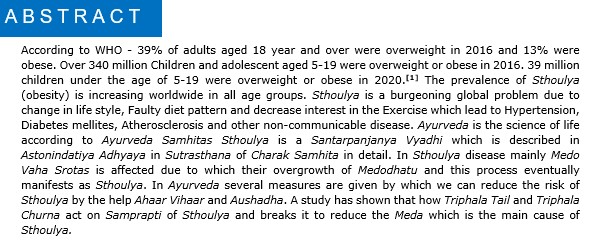Concept of Sthoulya in Ayurveda and its management with Pathya Apathya
DOI:
https://doi.org/10.21760/jaims.9.1.10Keywords:
Sthoulya, Santarpanjanya Vyadhi, Astonindatiya Adhyaya, Medovaha Srotas, Medodhatu, Triphala Churna, Triphala TailAbstract
According to WHO - 39% of adults aged 18 year and over were overweight in 2016 and 13% were obese. Over 340 million Children and adolescent aged 5-19 were overweight or obese in 2016. 39 million children under the age of 5-19 were overweight or obese in 2020.[1] The prevalence of Sthoulya (obesity) is increasing worldwide in all age groups. Sthoulya is a burgeoning global problem due to change in life style, Faulty diet pattern and decrease interest in the Exercise which lead to Hypertension, Diabetes mellites, Atherosclerosis and other non-communicable disease. Ayurveda is the science of life according to Ayurveda Samhitas Sthoulya is a Santarpanjanya Vyadhi which is described in Astonindatiya Adhyaya in Sutrasthana of Charak Samhita in detail. In Sthoulya disease mainly Medo Vaha Srotas is affected due to which their overgrowth of Medodhatu and this process eventually manifests as Sthoulya. In Ayurveda several measures are given by which we can reduce the risk of Sthoulya by the help Ahaar Vihaar and Aushadha. A study has shown that how Triphala Tail and Triphala Churna act on Samprapti of Sthoulya and breaks it to reduce the Meda which is the main cause of Sthoulya.
Downloads
References
WHO. Obesity and Overweight [Internet]. Available from: https://www.who.int/news-room/fact-sheets/detail/obesity-and weight.
Patley S, Kande A, Diwan R. A Review Article in World Journal of Pharmaceutical Research. World J Pharm Res. 2018;7(16):133-142.
Sharma PV. Charaka Samhita Part 1. Chaukhambha Orientalia, Varanasi; 2004. 9th ed. Sutra Sthana 21/3:144.
Sharma PV. Charaka Samhita Part 1. Chaukhambha Orientalia, Varanasi; 2004. 9th ed. Sutra Sthana 28/1:229.
Sharma AK. Kaya Chikitsa, Part 3rd. Chaukhambha Orientalia, Delhi; 2011. P. 174-177, 180.
Dhanya KV. A Birds Eye View on Metabolic Syndrome with Special Reference to Obesity (Sthoulya). IAMJ. 2017 Jun; ISSN 2320-5091:1972.
Tabassum, Patil UA. A review Article of A comparative Clinical study of Triphaladi Taila Abhyanga and Triphaladi Choorna Udhvartana in Management of Sthoulya. J Ayurveda Integr Med Sci (JAIMS).
Humanabad S, Katti BH, Kannolli GN, Sajjanshetty MR. Ahara as Pathya and Apathya in Sthoulya (Obesity). JAIMS.
Yogratnakar. Siddhinandan Mishra, Acharya. Siddhiprada Vyakhaya Yukta. Chaukhambha Orientalia. Chapter 40/9.















